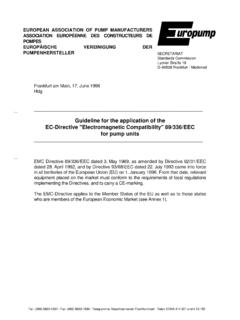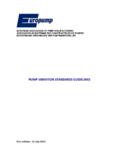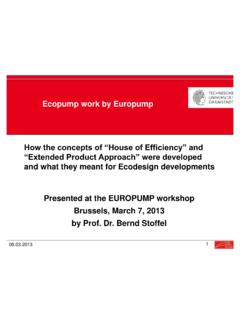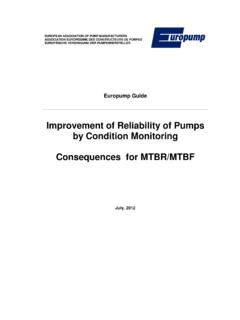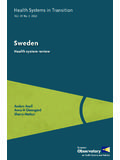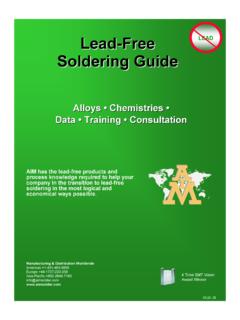Transcription of EUROPUMP ATEX Guideline Part I
1 EUROPEAN ASSOCIATION OF PUMP MANUFACTURERS. ASSOCIATION EUROP ENNE DES CONSTRUCTEURS DE POMPES. EUROP ISCHE VEREINIGUNG DER PUMPENHERSTELLER. EUROPUMP ATEX Guideline part I. BASIC requirements of Directive 94/9/EC. January 2008. ATEX Guideline - part I. 1. Foreword 3. 2. Introduction 3. 3. Scope and field of application 4. ) Scope 4. ) Excluded products 5. 4. Definitions 6. 5. General concepts 7. ) Placing ATEX products on the market 7. ) Putting ATEX products into service 8. ) Which kinds of products are covered by Directive 94/9/EC? 8. 6. Criteria determining the classification of equipment-groups 9. ) Groups and Categories 9. ) Temperature classification 10. ) Gas Groups 10. ) Details of the conformity assessment procedures 10. ) Conformity assessment responsibilities for Group II 14. ) What is a Technical File / Dossier? 15. 7. Steps to achieve ATEX compliance for categories 2, M2 and 3 15. 8. Documentation 17. ) Technical File (Dossier) 17. ) Instructions for use 17.
2 9. Marking 18. 10. EC Declaration of conformity 20. ) General 20. ) Contents 20. 11. Relevant harmonised standards 21. 12. Links between EC ATEX guidelines and EUROPUMP guidelines 22. ATEX Guideline - part I. 1. FOREWORD. EUROPUMP is the European Association of Pump Manufacturers. EUROPUMP has 18. members which are national industry associations representing pump manufacturers in Europe: Austria (FMMI), Belgium (Agoria), Czech Republic (Czech Pump Manufacturers Association), Denmark (Association of Danish Pump Manufacturers), Finland (The Federation of Finnish Technology Industries), France (Profluid), Germany (VDMA), Greece (Union Of Greek Metal Industries), Italy (Assopompe), Netherlands (Holland Pump Group), Poland (Stowarzyszenie Producentow), Romania (APPR), Russia (RPMA), Spain (Asociacion Espanola de Fabricantes de Bombas para Fluidos), Sweden (SWEPUMP), Switzerland (SWISSMEM), Turkey (POMSAD), United Kingdom (BPMA). Within the European Union (EU), the member associations represent more than 450 enterprises with a collective annual production worth more than 6 billion Euros.
3 This EUROPUMP Guideline has been prepared by the EUROPUMP Standards Commission. 2. INTRODUCTION. Hazards derived from ignition sources in potentially explosive atmospheres, have been recognised for many years. Formal requirements have been derived for electrical equipment, and experience has led to local or industry related requirements for mechanical or other hazards. Electrical hazards have been reduced by the use of design standards and by different certification schemes. Non-electrical hazards are sometimes covered by legally enforceable requirements such as those concerning underground mining or gasoil pipelines. Others have been imposed by contract, national and commercial undertakings. In order to fulfil the requirements of free trade in the EU, see article 95 of the Treaty of Rome, the member states of the EU have agreed essential safety requirements for equipment intended to be used in potentially explosive atmospheres. Conformity to these requirements is indicated by a CE marking, and member states may not hinder the sale of such equipment within their territories.
4 These essential requirements cover potential sources of electrical and non-electrical explosive hazards. The European Commission has published Directive 94/9/EC, often referred to as the ATEX. Directive. Directive 94/9/EC came into force on 1st March 1996, with a transition period until 30th June 2003. Therefore from 1st July 2003, all products within the scope of ATEX Directive must comply. 3. ATEX Guideline - part I. This Directive is linked to the user's ATEX Directive (Directive 99/92/EC1), which aims to improve safety of workers exposed to explosion hazards. In this view, Directive 99/92/EC. requires that employers take technical and/or organisational measures, in order of priority, and in accordance with the following basic principles: Prevent the formation of explosive atmospheres;. Avoid the ignition of potentially explosive atmospheres that cannot prevent;. Ensure the health and safety of workers by controlling the detrimental effects of an explosion which cannot be avoided.
5 Disclaimer This EUROPUMP Guideline part 1 - Basic requirements of ATEX Directive 94/9/EC is intended to give basic guidance to pump manufacturers who wish to supply products that will be within the scope of Directive 94/9/EC. EUROPUMP recommends that manufacturers should use this document as guidance only. Its contents are given in good faith but EUROPUMP cannot accept any responsibility for misinterpretation. 3. SCOPE AND FIELD OF APPLICATION. ) Scope The objective of Directive 94/9/EC is to ensure free movement in the EU territory, for the products2 to which it applies. Therefore the Directive, based on Article 95 of the EC. Treaty, provides for harmonised requirements and procedures to establish compliance. Annex II of the Directive states the Essential Health and Safety Requirements (EHSR) related to ingnition prevention, with respect to: Potential ignition sources of equipment intended for use in potentially explosive atmospheres;. Autonomous protective systems intended to come into operation following an explosion with the prime objective to halt the explosion immediately and/or limit the effects of explosion flames and pressures.
6 Safety devices intended to contribute to the safe functioning of such equipment with respect to ignition source and to the safe functioning of autonomous protective systems;. Components with no autonomous function, but are essential to the safe functioning of such equipment or autonomous protective system(s). 1. Directive 1999/92/EC of the European Parliament and of the Council of 16 December 1999 on minimum requirements for improving the safety and health protection of workers potentially at risk from explosive atmospheres. 2. Wherever the term products is used in the text of this Guideline the reader should be reminded, that all recommendations and interpretations made in this Guideline are refering to pumps. 4. ATEX Guideline - part I. Since 1 July 2003 relevant products could only be placed on the market in the EU territory, freely moved and operated as designed and intended, in the expected environment, if they comply with Directive 94/9/EC (and other relevant legislation).
7 Directive 94/9/EC provides, for the first time, harmonised requirements for non-electrical equipment and protective systems. Safety devices intended for use outside explosive atmospheres which are required for, or contribute to, the safe functioning of equipment or protective systems with respect to risks of explosion are also included. This is an increase in scope compared to former national regulations for equipment and systems intended for use in potentially explosive atmospheres. The scope of this Guideline is restricted to pumps. It outlines the compliance approach for all groups and categories, but gives details for Group l Category M2 and Group II Categories 2. and 3 only, which will be the very large majority of pumps. Readers having a good knowledge of ATEX may move to EUROPUMP guidelines part ll. Both Parts l and ll are based on the official ATEX guidelines issued by the European Commission and which can be downloaded from DG Enterprise web site. In this EUROPUMP Guide, each time a paragraph is related to a section in the EC guidelines , reference is given in the heading.
8 See also EUROPUMP Guide part l Section 12. ) Excluded products Directive 94/9/EC specifically identifies excluded products which may involve some types of pumps. Pump manufacturers will need to examine the areas of applicability and exclusions to determine whether or not the pump is subject to Directive 94/9/EC. Products intended for the following purposes are excluded from Directive 94/9/EC (Chapter 1, Art. ): Medical devices intended for use in a medical environment;. Equipment and protective systems where the explosion hazard results exclusively from the presence of explosive or chemically unstable substances;. Equipment intended for use in domestic and non-commercial environments where potentially explosive atmosphere may only rarely be created, solely as a result of the accidental leakage of a fuel gas;. Personal protective equipment subject to other directives;. Seagoing vessels and mobile offshore units together with equipment on board such vessels or units;. Means of transport for goods or people, other than vehicles intended for use in explosive atmospheres.
9 Equipment for military purposes. 5. ATEX Guideline - part I. 4. DEFINITIONS. Directive 94/9/EC contains the following definitions (Chapter 1, Art. ): Equipment Machines, apparatus, fixed or mobile devices, control components and instrumentation thereof and detection or prevention systems which, separately or jointly, are intended for the generation, transfer, storage, measurement, control and conversion of energy or the processing of material and which are capable of causing an explosion through their own potential sources of ignition. Protective system Design units which are intended to halt incipient explosions immediately and/or to limit the effective range of explosion flames and explosion pressures; protective systems may be integrated into equipment or separately placed on the market for use as autonomous systems. Device Safety devices, controlling devices and regulating devices intended to be used outside potentially explosive atmospheres but required for, or contributing to, the safe functioning of equipment and protective systems with respect to the risks of explosion.
10 Component Any item which is essential to the safe functioning of equipment and protective systems but with no autonomous function. Intended use The use of equipment, protective systems, and devices in accordance with the equipment group and category and with all the information supplied by the manufacturer which is required for the safe functioning of equipment, protective systems and devices. Explosive atmosphere The mixture with air, under atmospheric conditions, of flammable substances in the form of gases, vapours, mists or dusts in which, after ignition has occurred, combustion spreads to the entire unburned mixture. Potentially explosive atmosphere An atmosphere which could become explosive due to local and/or operational conditions. NOTE: Further definitions are given in EN 1127-1: Explosive atmospheres - Explosion prevention and protection - part 1: Basic concepts and methodology and EN 50014: Electrical apparatus for potentially explosive atmospheres - General requirements.
